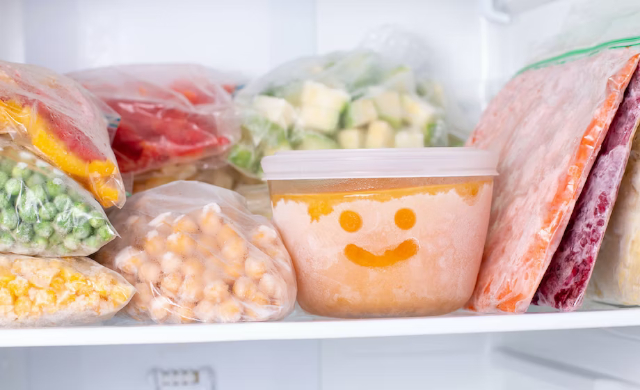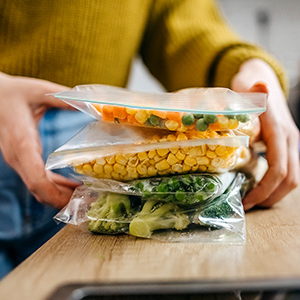Yesterday, we looked at some traditional – and some more creative – ways to use up leftovers from those fabulous family feasts. It’s been suggested that we follow-up today with a look at storage recommendations for specific foods…

First, allow me to present a concise, quick reference chart, organized by food type, that you can print out and post on your fridge…
Food Storage Master Reference
| Type of Food | Fridge | Freezer |
| Bacon, ham, hot dogs, and cooked sausage (links and patties) |
1 week | 1 month |
| Bread | 3 to 5 days | 1 to 3 months |
| Butter | 1 to 2 months | 6 to 9 months |
| Cake | 1 week | 6 months |
| Cheese, hard (i.e. cheddar, swiss, Parmesan) |
3 to 4 weeks | 6 months |
| Cheese, soft (brie, goat) | 1 to 2 weeks | 6 months |
| Chicken nuggets or patties | 3 to 4 days | 1 to 3 months |
| Fried chicken | 3 to 4 days | 4 months |
| Rotisserie chicken | 3 to 4 days | 4 months |
| Deli meat | 3 to 5 days | 1 month |
| Egg casseroles | 3 to 4 days | 2 to 3 months |
| Eggs, hard-boiled in shells | 1 week | not recommended |
| Egg substitutes, liquid | 3 days | not recommended |
| Fruit, sliced | 3 to 4 days | 3 months |
| Mashed potatoes | 3 to 4 days | 1 to 2 months |
| Meat or poultry, cooked | 3 to 4 days | 2 to 6 months |
| Milk | use-by date | 3 months |
| Pancakes and waffles | not recommended | 2 months |
| Pasta | 3 to 5 days | 1 to 2 months |
| Pies, fruit or nut | 3 to 4 days | up to 4 months |
| Pies, custard or chiffon | 3 to 4 days | not recommended |
| Pizza | 3 to 4 days | 1 to 2 months |
| Quiche | 3 to 5 days | 2 to 3 months |
| Quinoa | 1 week | 6 to 12 months |
| Rice | 4 to 6 days | 6 months |
| Salad (chicken, egg, ham, tuna, and macaroni) |
3 to 4 days | not recommended |
| Soup | 3 to 4 days | 2 to 3 months |
| Tofu | 1 week | 5 months |
| Vegetables | 3 to 4 days | 1 to 2 months |
Thank you, U.S. Department of Agriculture, for this great quick reference!
Other Resources
The website FoodSafety.gov offers a unique digital app that provides specific guidelines for storing hundreds of fresh and leftover foods. ‘The FoodKeeper’ can be used on desktops, tablets and smart phones.
The USDA Food Safety and Inspection Service also offers a comprehensive website that covers the broader subject of food handling.
To Refreeze or not?
This question has generated so much controversy, over the decades since home deep-freezers have been around, that many folks are pretty hazy on it. But I’m happy to say the current versions of official government recommendations all agree that you can thaw and refreeze most foods. Care must be taken to observe safe food handling temperature rules and minimize ‘open times’.
Other adjustments are made periodically as new research emerges.
Be proactive
The best approach to leftover handling, and particularly the issue of storage, is to plan ahead and be proactive. Simply, try to plan your big feasts minimize the the amount of leftovers.
Plan to make spin-off meals from the leftovers, such as casserole, to minimize the amount of food requiring long-term storage.
Process leftovers for longer-term storage (mainly freezing, at this point) as soon as possible after the original big meal.
Make sure to label all containers with the date they were frozen to ensure the oldest leftovers are always used up first.
And always remember…
One rule still rules
And this one is just about as simple as they come: When in doubt, throw it out!
~ Maggie J.

